David's Astronomy Pages
|
Notes (S359) |
Notes (Main) |
Home Page |
Notes (S361) |
|
2009-04-01 Reduced Star Drift Tracking Rate Adjustment Trials Seeing / Atmospheric Refraction Effect Collimation and Image Curvatures Measurements >
Small adjustments to scope's tracking rate and PEC (Periodic Error Correction) training are now showing some benefits. The following images compare two sets of stacked frames : one from the present session (S360) and one from the 'First Light Session' (S356). Both cover 16 minute intervals
|
Results of recent PEC Training and
Tracking Rate Adjustment, 2009-04-01 |
|
|
|
Annotated CCD Image 32 x 15s sec exposure (average combined / no alignment on stars) 3x3 binning, C Filter, Cropped 2009-04-01 20:00 - 21:16h UT (#360001-46) 12" LX200R (at f/5.7) + ST-10XME |
|
|
|
Earlier Star drift and periodic error
effects - 2009-03-09 Note: Comet C/2007 N3 (Lulin) records a higher drift rate due to its motion relative to background stars. |
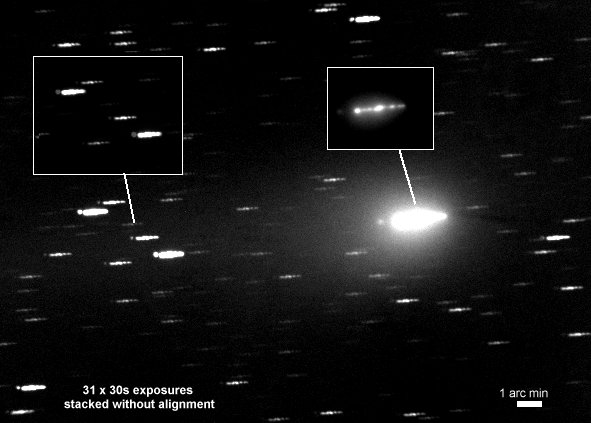
|
|
Annotated CCD Image 30 x 30s sec exposure (average combined / no alignment on stars or comet) 3x3 binning, C Filter, Cropped 2009-03-09 21:08 - 21:24h UT (#356006-35) 12" LX200R (at f/5.8) + ST-10XME |
|
|
|
Star Drift (RA) Measurements / IC 531 starfield, 2009-04-01 |
|
Positional measurements on from a 16
minute period (smeared star frames not used) |
|
|
|
|
|
Star Drift (RA) Measurements / NGC 2877 starfield, 2009-04-01 |
|
Positional measurements on from a 16
minute period (NGC 2877) |
|
|
|
|
Back to Top
Two additional tracking rate trial were carried out during the present session (including the set described above).
The two new measurements are added to the table below.
Session Tracking Rate
AdjustmentStar Drift (in RA) Actual Tracking Rate
Notes S356/357 'Sidereal' Westwards by 1.9 arc secs/minute Slow by 0.21% South Sky Point (w/o Pec) S358a 'Sidereal' Westwards by 3.2 arc secs/minute Slow by 0.34% South Sky Point (with Pec) Westwards by 4.1 arc secs/minute Slow by 0.34% West Sky Point (with Pec) S358b +3 Eastwards by 2.5 arc secs/minute Fast by 0.28% South Sky Point (with Pec) S359 +1 Westwards by 2.2 arc secs/minute Slow by 0.24% South Sky Point (w/o Pec) S360 +1 Westwards by 0.9 arc secs/minute ? Slow by 0.09% ? South Sky Point (with Pec) +2 Eastwards by 1.0 arc secs/minute Fast by 0.11% South Sky Point (with Pec)
Back to Top
Several frames collected for star drift tests
showed smeared/elongated stars, and were investigated further.
The star llongation of stars is considered to be some form of seeing/
atmospheric refraction effect as the elongation is clearly perpendicular to the
horizon, not to fork arm/RA lines
and other possibilities (tracking, PE, polar misalignement,) can be ruled out by
occurrence of normal frames with circular stars.
|
Results of recent PEC Training and
Tracking Rate Adjustment, 2009-04-01 |
||
|
|
||
|
Annotated CCD Image 46 x 15s sec exposure (average combined / no alignment on stars) 3x3 binning, C Filter, Cropped 2009-04-01 20:00 - 21:16h UT (#360001-46) 12" LX200R (at f/5.7) + ST-10XME |
||
|
|
||
|
Frame with Smeared/Elongated Stars |
||
|
|
||
|
Annotated CCD Image (65% size reduction, with 150%
size insert) 15s sec exposure (single frame), 3x3 binning, C Filter 2009-04-01 (#360001), 12" LX200R (at f/5.7) + ST-10XME |
||
|
|
||
|
Normal Frame - circular stars |
||

|
||
|
Annotated CCD Image (65% size reduction, with 150%
size insert) 15s sec exposure (single frame), 3x3 binning, C Filter 2009-04-01 (#360029), 12" LX200R (at f/5.7) + ST-10XME |
||
|
Frames showing orientation of smeared stars relative to horizon grid lines |
||
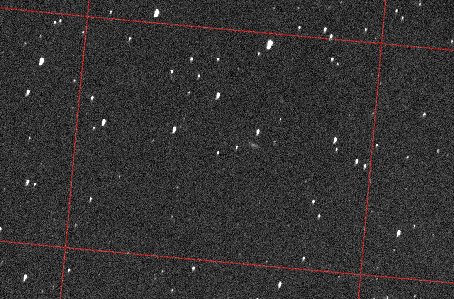
|

|
|
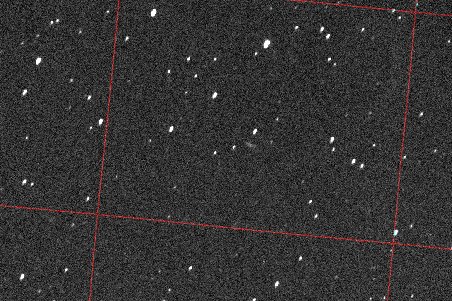
|
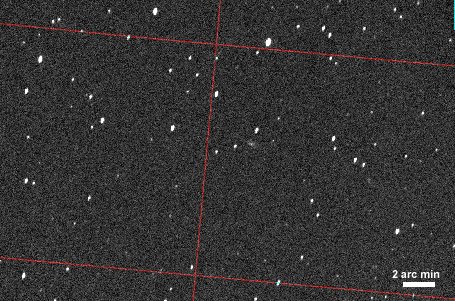
|
|
|
CCD Images (Image Linked within TheSky with Horizon
Grid lines - brown)) 15s sec exposure (single frames), 3x3 binning, C Filter 2009-04-01 (#360001, 360010, 360018, 236004)), 12" LX200R (at f/5.7) + ST-10XME |
||
Back to Top
An evaluation copy of CCD Inspector 2.1.6 (by
CCDWare) was used to re-collimate the LX200 scope using a star field with around
220 stars, lying at around 29 deg altitude. Conditions were not ideal for
performing a perfect collimation but an improvement of collimation was
undoubtedly achieved and the fine tuning was far easier/more reliable that
earlier visual/qualitative method. It was noted that only very small
movements of the collimation screws were necessary (2 - 3 degs of rotation)
Final estimated collimation error was around 3 - 4 arc secs, compared to a
immediately prior collimation error of 14 arc secs
(and compared against original first light collimation error of around 35-42
arc secs)
It is unclear why the collimation error immediately prior to re-collimation
attempt (14 arc secs) is rather less than the measurements made during session
S358 (31-37 arc secs) (Mirror slop ?, seeing)
Collimation error, as measured by CCDI, is the offset between the optical center and physical center of the imaging train as measured at the image plane. The secondary mirror is adjusted until this error is minimized. Rules of thumb for collimation error are : An error of 10 arcseconds or less is acceptable, but can be improved upon, if seeing allows - An error of 5 arceconds or less is perfect, and doesn't require adjustment.
|
Collimation Measurements (pre Re-Collimation) |
|
|
|
CCD Inspector plot 20s sec exposure, 2x2 binning, C Filter (#360245) 12" LX200R (at f/5.7) + ST-10XME |
|
|
|
Collimation Measurement (post Re-Collimation) |
|
|
|
CCD Inspector plot 20s sec exposure, 2x2 binning, C Filter (#360292) 12" LX200R (at f/5.7) + ST-10XME |
|
|
|
Image Prior to Re-Collimation |
|
|
|
CCD Image (50% size reduction) 20s sec exposure (single frame), 3x3 binning, C Filter 2009-04-1 21:08 - 21:24h UT (#360245) 12" LX200R (at f/5.7) + ST-10XME |
|
|
|
Image After Re-Collimation |
|
|
|
CCD Image (50% size reduction) 20s sec exposure (single frame), 3x3 binning, C Filter 2009-04-1 21:08 - 21:24h UT (#360292) 12" LX200R (at f/5.7) + ST-10XME |
|
Graphs showing progressive improvement in Collimation Quality during
re-collimation a reasonable collimation position was obtained part way through the sequence but was lost again as further improvement was attempted. Collimation attempt was stopped when approximately equivalent quality was obtained. |
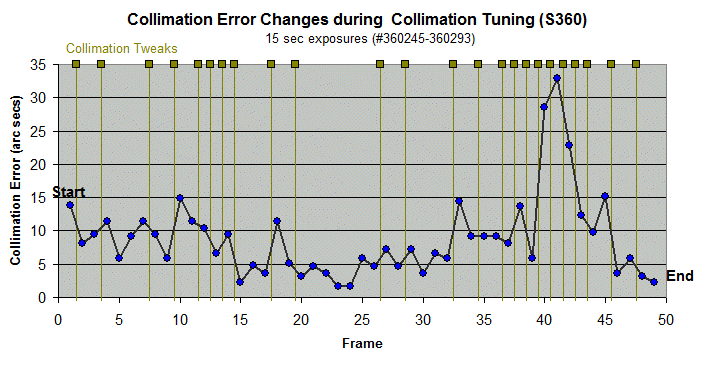
|
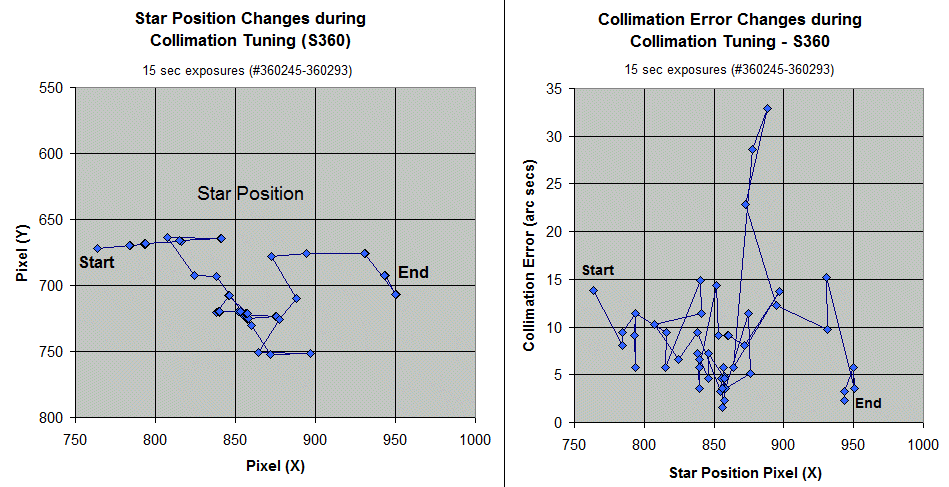
|
Table of Collimation / Curvature Measurements - 12" LX200R (at f/5.7) + ST-10XME
Session Images Stars
Aspect
Ratio
Curvature
Collimation
(arc secs)Average FWHM
(arc secs)Tilt X Tilt Y Total Tilt S356 (First Light Session) 30 x 30s 148 +/- 13 38 % +/- 20% 16 % +/- 1% 41.6" +/- 6.3" 5.4" +/- 0.7" -0.9" +/- 0.1" -0.3" +/- 0.1" 16% @ -157 deg S356 (First Light Session) 6 x 60s 410 +/- 22 38 % +/- 10% 27 % +/- 1% 35.0" +/- 6.5" 5.3" +/- 0.3" -1.1" +/- 0.2" +0.5" +/- 0.1" 20% @ -149 deg S357 collimation attempt S358 7 x 90s 575 +/- 40 19% +/- 8% 24 % +/- 2% 36.3" +/- 6.3" 5.5" +/- 0.4" +0.9" +/- 0.2" +0.1" +/- 0.1" 15% @ - 5 deg S358 6 x 45s 633 +/- 73 14% +/- 3% 21 % +/- 2% 31.7" +/- 7.6" 4.9" +/- 0.4" +0.7" +/- 0.2" +0.3" +/- 0.1" 10% @ - 22 deg S358 3 x 60s 695 +/- 80 16% +/- 6% 24 % +/- 1% 36.1 +/- 4.0" 5.9" +/- 0.6" +0.9" +/- 0.1" +0.1" +/- 0.0" 14% @ - 9 deg S360 2 x 20s 199 +/- 1 16% +/- 4% 22 % +/- 3% 13.9 +/- 1.3" 4.0" +/- 0.2" +0.6" +/- 0.1" +0.0" +/- 1.0" 12% @ - 9 deg S360 3 x 20s 184 +/- 27 27% +/- 5% 24 % +/- 6% 14.7 +/- 1.5" 4.2" +/- 0.3" +0.5" +/- 0.1" -0.1" +/- 0.1" 12% @ 19 deg S360 - Collimation attempt S360 - Post Collimation 4 x 20s 223 +/- 13 17% +/- 1% 17 % +/- 3% 3.7 +/- 1.0" 4.0" +/- 0.1" +0.2" +/- 0.1" -0.1" +/- 0.1" 4% @ 20 deg
Back to Top
| This Web Page: | Notes - Session 360 (2009-04-01) |
| Last Updated : | 2015-05-16 |
| Site Owner : | David Richards |
| Home Page : | David's Astronomy Web Site |